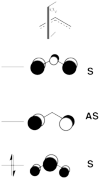VBTutorial3
How to modify this page :
- first : log in (top right of this page) ;
- click on [edit] (far right) to edit a section of the page ;
- write your text directly in the wiki page, and click on the "Save page" button (bottom left) to save your modifications
Pictures : how to insert a picture in your text
See also this page for an introduction to the basics of the wiki syntax
To the Tutors
Sason remarks and prospective 2 hours talk +
Philippe's remark on the initially proposed tutorial. are included in bold.
Qualitative
- State correlation Diagrams in 3 centers systems : H3C. - H. - .CH3 (or 4 electrons .... H transfer barrier appearing in F H F(-) when the F ... F distance is increased (which avoids geometry problems).
Yes, but we could start with H3
- Benzen pi system dissymetrization (2 geometries (D6h and D3h); on each geometry 2 spin alternant determinants cf p154 on The Book) - Pbm : check how differentiate sigma vs + (sigma + pi) energies.
Objection : Using two spin-alternant determinants refers to Heisenberg’s spin hamiltonian theory, that we don’t teach. Differentiating sigma vs sigma + pi energies is a bit off-topic.
Exercices
Exercice 1 (paper exercice) : Conical intersection in H3. radical
Consider three hydrogen atoms Ha, Hb, Hc, with respective atomic orbitals a, b and c, and the two VB structures R = and P = . The Ha-Hb and Hb-Hc distances are equal.
- By using the thumb rules recalled below, where squared overlap terms are neglected, derive the expression of the energies of R and P, and of the reduced Hamiltonian matrix element between R and P for the 3-orbital/3-electrons reacting system [Ha--Hb--Hc]•.
- From the sign of this latter integral when θ > 60°, derive the expressions of the ground state Ψ≠ and of the first excited state Ψ* of the H3• system. One may drop the normalization constants for simplicity. What bonding scheme does the excited state represent ?
- Show that the reduced Hamiltonian matrix element is largest in the collinear transition state geometry, and drops to zero in the equilateral triangular structure.
- Show that R and P VB structures are degenerate in the equilateral triangular structure, and that Ψ≠ and Ψ* are also degenerate in this geometry.
- We now extend the above conclusions to the allyl radical. What are the bonding schemes corresponding to the ground state and first excited state ? What geometrical distortion would make these two states degenerate ? What would be the end product of a photochemical excitation of allyl radical to its first excited state ?
Appendix : Thumb rules for the calculations of effective Hamiltonian matrix elements between determinants.
- Energy of a determinant D : ... (if orbitals i and j have parallel spins)
- Matrix element between determinants differing by spin inversion of two spin-orbitals :
Exercice 2 : computation of H—H + H. -> H. + H—H hydrogen exchange state correlation diagram
Subject
Here is a image example
To do
Access to files :
Exercice 3 : Computation of state correlation Diagrams for a 3 centers / 4 electrons system
Sason's remark :
" F(-) + H-F example is not good by itself, unless you also do F• + H-F - showing that in one case you have an intermediate FHF(-) and in the other case you have a high barrier.
If we just want to do one case of 4-electron/3-center reaction, we should use Cl(-) + CH3Cl.
The audience will appreciate a more chemical example, which is Cl(-) + CH3Cl. "
